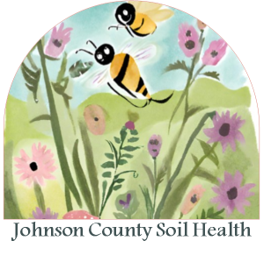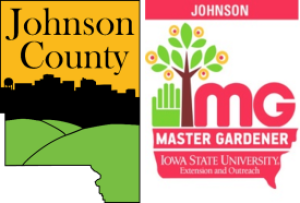 Johnson County
Johnson County
Pocket Prairie Program
The Johnson County Pocket Prairie Program is a collaboration between Johnson County and the Master Gardeners of Johnson County, providing plants, training, information, and technical assistance to guide participants in adding high-value native plants to their yards, creating a 10' by 10' pocket prairie. These native plantings provide critical pollinator habitat for bees, butterflies and more, and also improve soil health. Healthy soil helps infiltrate more rainfall and keep pollutants out of our creeks and streams.
Read more about the program in this recently published Cedar Rapids Gazette Article.
Application to the Program
Application for the 2026 planting season is currently closed.
Why a Pocket Prairie Program
Native plants improve soil health.
Adding native plants to your yard or landscape is an excellent way to improve your soil health. Native plants have extensive root systems that range from 5-15' deep. These roots help break up heavy clay soils, stabilize the soil, and create pore spaces that facilitate the movement of air, water, and organisms.
With the above-ground plant mass and a portion of the underground root mass dying back every season, these plants also provide a continuous source of organic matter. Organic matter can hold up to 90% of its weight in water, significantly increasing the ability of soil to soak up and store water.
Native plants provide habitat.
Native plants provide critical habitat for pollinators as well as other insects, birds, and wildlife. Even small additions (like pocket prairies!) can have positive impacts.
Native plants reduce inputs.
Native plants thrive in local conditions, and their resilience reduces the need for watering, fertilization, and pest control.
Requirements
- Must be a resident in the unincorporated area of Johnson County.
- Must provide a map of the property and where the pocket prairie will be located.
- Must commit to 3 years of maintenance (sleep, creep, and leap!) to establish the pocket prairie.
- Must have suitable site conditions.
- Must convert an area that is currently maintained.
Plants
Each approximately 100 square foot pocket will have 100 plants in total, with a mix of 8 forbs and 2 grasses.
A predefined set of plants is free to program participants.
- Summer Sun
Full sun pockets require 6 hours or more of direct sunlight per day. Plants include:
- Black-Eyed Susan
- Butterfly Weed
- Little Bluestem
- Pale Purple Coneflower
- Prairie Blazing Star
- Prairie Dropseed
- Purple Prairie Clover
- Silky Aster
- Smooth Blue Aster
- White Prairie Clover
- Speckled Shade
Part shade pockets require 3-6 hours of sunlight per day.
- Culver's Root
- Large Flowered Primrose
- Common Oak Sedge
- Curley Wood Sedge
- Nodding Wild Onion
- Prairie Alum Root
- Prairie Sundrops
- Eastern Bluestar
- False Aster
- Sweet Black-Eyed Susan
- Drizzle Dazzle
Part sun/moist pockets require 3-6 hours of direct sunlight. Plants include:
- Blue Flag Iris
- Bur Sedge
- Cardinal Flower
- Culver's Root
- Common Rush
- Dudley's Rush
- Fox Sedge
- Golden Alexanders
- Great Blue Lobelia
- Prairie Sundrops
Process
- Apply to the program (applications are accepted starting in July each year).
- Attend the Pocket Prairie Program Workshop (held in August).
- Plan your garden location and shape.
- Prepare your site. Site preparation is key, and must be completed no later than October 15 to remain in the program.
- Plant your pocket prairie, and mark your plants! Water well during establishment.
- Monitor and maintain your plot. If you have concerns during this time, you will have access to experts with the Master Gardeners.
Prepare, Plant, and Maintain Your Plot
Resources and Articles
Events
Johnson County Soil Health Main Page

